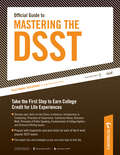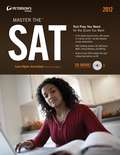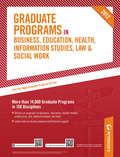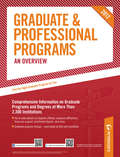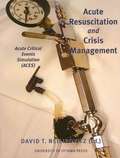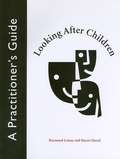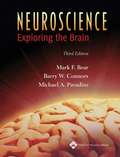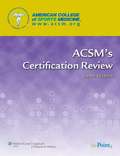- Table View
- List View
Official Guide to Mastering DSST Exams--Principles of Public Speaking: Chapter 6 of 8
by Peterson's"A part of Peterson's Official Guide to Mastering the DSST Exams--Principles of Public Speaking helps nontraditional students earn college credits for life and learning experiences, with a diagnostic test, subject review, and post-test (with detailed answer explanations) for this popular DSST exam. Topics include ethical considerations in public speaking, audience analysis and adaptation, speech topics and purposes, research and organization; criticizing and evaluating speeches, and more. Peterson's Official Guide to Mastering the DSST Exams is the only prep guide endorsed by PrometricTM, the DSST program provider, which found this study guide to be an excellent reflection of the content of the respective DSST tests."
Two-Year Colleges 2012
by Peterson'SPeterson's Two-Year Colleges 2012 includes information on more than 1,800 accredited two-year undergraduate institutions in the United States and Canada, as well as some international schools. It also includes detailed two-page descriptions written by admissions personnel. Inside you'll also find: Detailed information on campus setting, enrollment, majors, expenses, student-faculty ratio, application deadline, and contact information. Helpful articles on what you need to know about two-year colleges: advice for adult students on transferring and returning to school ; how to survive standardized tests; what international students need to know about admission to U.S. colleges; how to manage paying for college; and interesting "green" programs at two-year colleges State-by-state summary table allows comparison of institutions by a variety of characteristics, including enrollment, application requirements, types of financial aid available, and numbers of sports and majors offered Informative data profiles for more than 1,800 institutions, listed alphabetically by state (and followed by other countries) with facts and figures on majors, academic programs, student life, standardized tests, financial aid, and applying and contact information Indexes offering valuable information on associate degree programs at two-year colleges and four-year colleges-easy to search alphabetically
Master the SAT Basics: Part I of V
by Peterson'sPeterson's Master the SAT: Basics contains essential information about all aspects of the SAT. Readers will learn about what kinds of questions to expect, how the tests are scored and reported, and how to get ready the night before and day of the test. Peterson's Master the SAT provides students with detailed strategies to help maximize their test scores AND offers hundreds of practice questions to help them prepare for test day. For more information see Peterson's Master the SAT.
Master the SAT: Part II of V
by Peterson'sPeterson's Master the SAT: Diagnosing Strengths and Weaknesses contains a diagnostic test designed to help test-takers assess their abilities on the SAT. The test contains critical reading, writing, and math questions-all with detailed answer explanations. In addition, there is a score sheet and a comparison chart to help test-takers pinpoint relative strengths and weaknesses. Peterson's Master the SAT provides students with detailed strategies to help maximize their test scores AND offers hundreds of practice questions to help them prepare for test day. For more information see Peterson's Master the SAT.
Master the SAT Critical Reading: Part III of V
by Peterson'sPeterson's Master the SAT: Critical Reading helps test-takers learn about sentence completion and reading strategies while offering dozens of practice exercises. Readers will learn about the basic steps for solving sentence completion questions and understanding critical reading passages. Peterson's Master the SAT provides students with detailed strategies to help maximize their test scores AND offers hundreds of practice questions to help them prepare for test day. For more information see Peterson's Master the SAT.
Master the SAT Writing: Part IV of V
by Peterson'sPeterson's Master the SAT: Writing provides an in-depth review of the SAT essay. Test-takers will find informative writing strategies, including information on multiple-choice writing questions (identifying sentence errors, improving sentences, and improving paragraphs), an explanation of the writing process and the SAT essay, and a guide to good writing, which includes vocabulary lists of irregular verbs and confusing words. Peterson's Master the SAT provides students with detailed strategies to help maximize their test scores AND offers hundreds of practice questions to help them prepare for test day. For more information see Peterson's Master the SAT.
Master the SAT Math: Part V of V
by Peterson'sPeterson's Master the SAT: Math gives test-takers essential strategies for multiple-choice and grid-in questions. It includes helpful reviews of numbers and operations, basic algebra, functions and intermediate algebra, geometry, data analysis, statistics, and probability. Peterson's Master the SAT provides students with detailed strategies to help maximize their test scores AND offers hundreds of practice questions to help them prepare for test day. For more information see Peterson's Master the SAT.
Master the SAT: Practice Test 2 of 6
by Peterson'sPeterson's Master the SAT: Practice Test 2 features a full-length SAT exam with detailed answer explanations. The practice test is designed to prepare test-takers for the critical reading, writing, and math questions-as well as the written essays-they will find on the actual exam. Peterson's Master the SAT provides students with detailed strategies to help maximize their test scores AND offers hundreds of practice questions to help them prepare for test day. For more information see Peterson's Master the SAT.
Master the SAT: Practice Test 3 of 6
by Peterson'sPeterson's Master the SAT: Practice Test 3 features a full-length SAT exam with detailed answer explanations. The practice test is designed to prepare test-takers for the critical reading, writing, and math questions-as well as the written essays-they will find on the actual exam. Peterson's Master the SAT provides students with detailed strategies to help maximize their test scores AND offers hundreds of practice questions to help them prepare for test day. For more information see Peterson's Master the SAT.
Master the SAT: Practice Test 4 of 6
by Peterson'sPeterson's Master the SAT: Practice Test 4 features a full-length SAT exam with detailed answer explanations. The practice test is designed to prepare test-takers for the critical reading, writing, and math questions-as well as the written essays-they will find on the actual exam. Peterson's Master the SAT provides students with detailed strategies to help maximize their test scores AND offers hundreds of practice questions to help them prepare for test day. For more information see Peterson's Master the SAT.
Master the SAT: Practice Test 5 of 6
by Peterson'sPeterson's Master the SAT: Practice Test 5 features a full-length SAT exam with detailed answer explanations. The practice test is designed to prepare test-takers for the critical reading, writing, and math questions-as well as the written essays-they will find on the actual exam. Peterson's Master the SAT provides students with detailed strategies to help maximize their test scores AND offers hundreds of practice questions to help them prepare for test day. For more information see Peterson's Master the SAT.
Master the SAT: Practice Test 6 of 6
by Peterson'sPeterson's Master the SAT: Practice Test 6 features a full-length SAT exam with detailed answer explanations. The practice test is designed to prepare test-takers for the critical reading, writing, and math questions-as well as the written essays-they will find on the actual exam. Peterson's Master the SAT provides students with detailed strategies to help maximize their test scores AND offers hundreds of practice questions to help them prepare for test day. For more information see Peterson's Master the SAT.
Peterson's Graduate Programs in Business, Education, Health, Information Studies, Law & Social Work 2012
by Peterson'sPeterson's Graduate Programs in Business, Education, Health, Information Studies, Law & Social Work 2012 contains a wealth of info on accredited institutions offering graduate degrees in these fields. Up-to-date info, collected through Peterson's Annual Survey of Graduate and Professional Institutions, provides valuable data on degree offerings, professional accreditation, jointly offered degrees, part-time & evening/weekend programs, postbaccalaureate distance degrees, faculty, students, requirements, expenses, financial support, faculty research, and unit head and application contact information. There are helpful links to in-depth descriptions about a specific graduate program or department, faculty members and their research, and more. Also find valuable articles on financial assistance, the graduate admissions process, advice for international and minority students, and facts about accreditation, with a current list of accrediting agencies.
Peterson's Graduate & Professional Programs: An Overview 2012
by Peterson'SGraduate & Professional Programs: An Overview 2012 contains nearly 2,400 university/college profiles that offer valuable information on graduate and professional degrees and certificates, enrollment figures, tuition, financial support, housing, faculty, research affiliations, library facilities, and contact information. This graduate guide enables students to explore program listings by field and by institution. Two-page in-depth descriptions, written by administrators at featured institutions, give complete details on the graduate study available. Readers will benefit from the expert advice on the admissions process, financial support, and accrediting agencies.
Applied Phonetics: The Sounds of American English (3rd edition)
by Harold T. EdwardsFor the third edition Edwards (communicative disorders and sciences, Wichita State U., Wichita, Kansas) has expanded the sections on dynamics of speech, American English dialects, and speech mechanism. As in earlier editions, the volume teaches the student to transcribe in the first part. The second part, which can be used as a reference work, contains an exhaustive resource for each of the sounds of American English. Annotation (c)2003 Book News, Inc., Portland, OR (booknews.com)
Taxation of Individual Income (Tenth Edition)
by J. Martin Burke Michael K. FrielTaxation of Individual Income is a leading casebook that employs a unique problem method, which many past students have found to be highly effective, stimulating, challenging and enjoyable. Students are provided material that allow them to arrive at their own conclusions about income tax concepts, rather than the text merely setting out such concepts for them. Each chapter begins with a set of problems with learning objectives and a list of relevant terms without definitions. These features are then followed by a detailed overview, relevant cases, administrative rulings, and legislative history. After reading the materials, students return to the beginning of the chapter to address the problems and define the vocabulary terms.
Understanding History: An Introduction to Analytical Philosophy of History
by Jonathan GormanThis book brings into question the very ability of historians to gather and communicate genuine knowledge about the past. Understanding History applies this general question from the philosophy of history to economic history of American slaveholders.
Acute Resuscitation and Crisis Management: Acute Critical Events Simulation (ACES)
by David T. NeilipovitzThis book is a compendium to the ACES Program, containing its important background information and reference material while serving as an independent reference source for physicians and other health care professionals.
Looking After Children: A Practitioner's Guide
by Hayat Ghazal Raymond LemayLooking After Children is an assessment and planning approach for children and youth in out-of-home care, first developed in the UK, and since 1997 adapted and used increasingly in Canada, particularly in Ontario. The approach is developmental and strengths based. The Assessment and Action Record (AAR), the core clinical tool, provides the basis for an in-depth assessment interview which then leads to a comprehensive care plan. The AAR is computerized and provides the possibility of data aggregation, and the recent revision allows for comparability among Canadian children as assessed by the National Longitudinal Survey of Children and Youth. Looking After Children: A Practitioner's Guide includes training material that will help practitioners understand and put the LAC approach and tools to effective use.
Computer-Aided Translation Technology: A Practical Introduction
by Lynne BowkerLynne Bowker introduces the world of technology to the world of translation in this unique book, the first of its kind. Bowker reveals the role of technology in translation and how to use this ever developing tool.
Tomorrow's Professor: Preparing for Careers in Science and Engineering
by Richard M. ReisTomorrow's Professor is designed to help you prepare for, find, and succeed at academic careers in science and engineering. It looks at the full range of North American four-year academic institutions while featuring 30 vignettes and more than 50 individual stories that bring to life the principles and strategies outlined in the book. Tailored for today's graduate students, postdocs, and beginning professors, Tomorrow's Professor: Presents a no-holds-barred look at the academic enterprise Describes a powerful preparation strategy to make you competitive for academic positions while maintaining your options for worthwhile careers in government and industry Explains how to get the offer you want and start-up package you need to help ensure success in your first critical years on the job Provides essential insights from experienced faculty on how to develop a rewarding academic career and a quality of life that is both balanced and fulfilling Bonus material is available for free download at http://booksupport.wiley.com At a time when anxiety about academic career opportunities for Ph. D. s in these field is at an all-time high, Tomorrow's Professor provides a much-needed practical approach to career development.
Neuroscience: Exploring the Brain (Third Edition)
by Mark F. Bear Barry W. Conners Michael A. ParadisoNeuroscience: Exploring the Brain surveys the organization and function of the human nervous system, presenting material at the cutting edge of neuroscience, in a way that is accessible to both science and nonscience students alike. The book is divided into four parts: Part I, Foundations; Part II, Sensory and Motor Systems; Part III, The Brain and Behavior; and Part IV, The Changing Brain.
ACSM's Certification Review (3rd edition)
by Khalid W. Bibi Michael G. NiederpruemACSM's Certification Review is a review manual for candidates wanting an ACSM credential including ACSM Certified Health Fitness Specialist (HFS), the ACSM Clinical Exercise Specialist (CES), and the ACSM Certified Personal Trainer (CPT) certifications. Content is based on the Knowledge, Skills, and Abilities (KSAs) found in ACSM's Guidelines for Exercise Testing and Prescription.
Synopsis of Psychiatry: Behavioral Sciences/Clinical Psychiatry (Tenth Edition)
by Benjamin J. Sadock Virginia A. SadockThe best-selling general psychiatry text since 1972, Kaplan and Sadock's Synopsis of Psychiatry is now in its thoroughly updated Tenth Edition. This complete, concise overview of the entire field of psychiatry is a staple board review text for psychiatry residents and is popular with a broad range of students in medicine, clinical psychology, social work, nursing, and occupational therapy, as well as practitioners in all these areas. The book is DSM-IV-TR compatible and replete with case studies and tables, including ICD-10 diagnostic coding tables. You will also receive access to the complete, fully searchable online text, an online test bank of approximately 100 multiple-choice questions and full answers, and an online image bank.
Massage Mastery: From Student To Professional
by Anne WilliamsThis comprehensive introductory massage text is organized into 24 chapters that cover the key areas addressed in massage programs of 500 to 1200 hours in length. Topics inside the chapters are structured to allow for manageable reading assignments that build a student's sense of accomplishment and motivation. Written and designed for today's adult learner, the book offers a broad discussion of foundation massage with appropriate depth for a beginning student progressing to an entry-level professional. It also contains new topics that are necessary to prepare today's adult learners for successful massage careers. (Note: It does not cover anatomy and physiology, as A&P is best thoroughly covered in a separate textbook. ) A helpful appendix on health care terminology, a comprehensive massage glossary, and a robust set of ancillary materials complete the package. The companion Study Guide contains topic-specific Rubrics, Learning Contracts, and a variety of exercises and activities for students.
